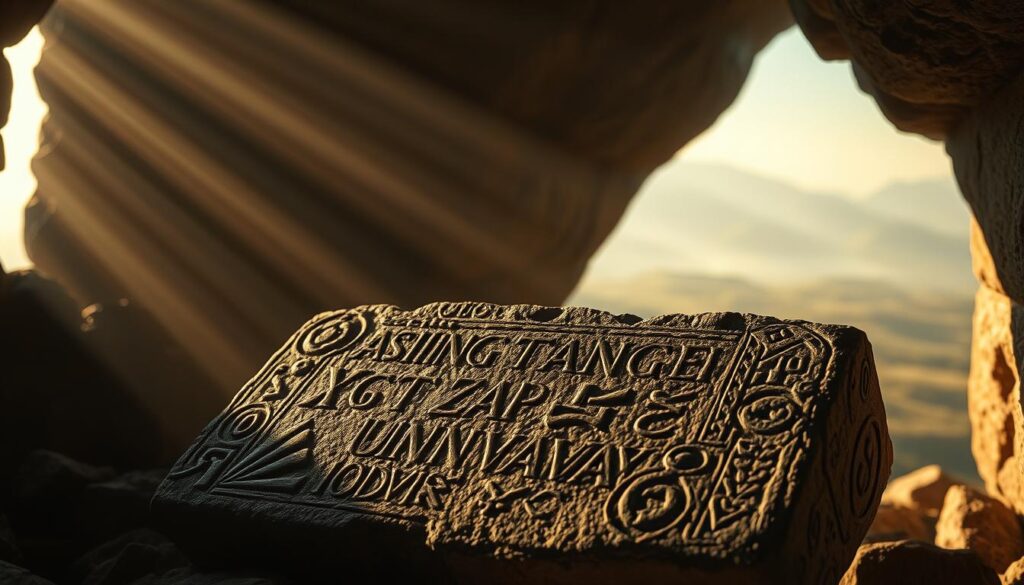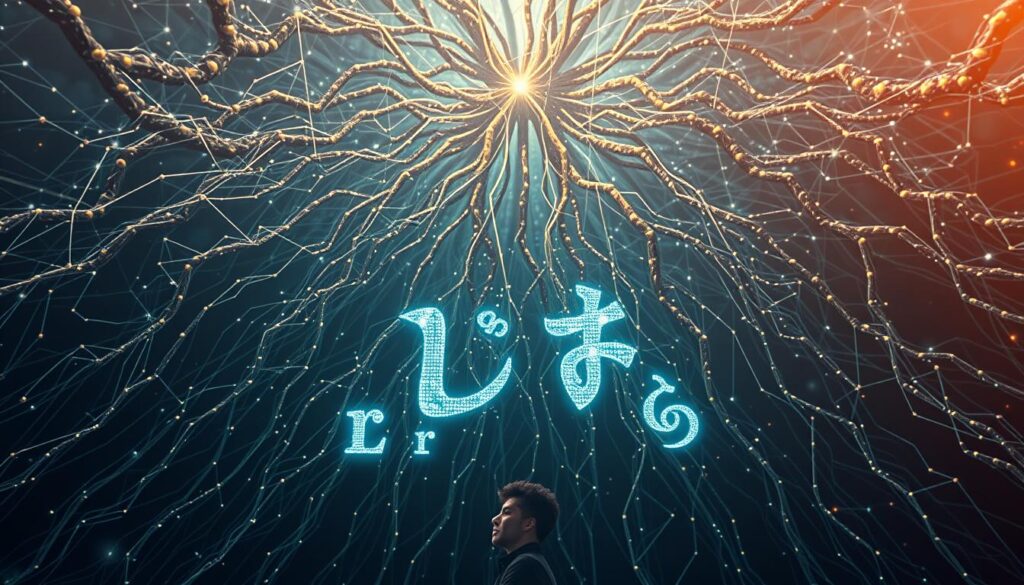The study of ancient languages and script decipherment has always fascinated us. Many have successfully cracked codes like Egyptian hieroglyphs. This journey into the unknown is not just interesting but also crucial. It lets us understand the cultures and histories of ancient civilizations.
Deciphering scripts is a challenging task. It needs a deep grasp of language patterns and cultural ties. By looking at past successes, we learn how to unlock these ancient texts. This shows us how vital linguistic analysis is in grasping our cultural roots.

Exploring unreadable languages shows us how vital they are. Script decipherment is key to understanding our shared history. Through detailed analysis, we uncover new insights and deepen our understanding of ancient cultures. This highlights the importance of both linguistic analysis and script decipherment.
Key Takeaways
- Understanding ancient languages is crucial for unlocking cultural and historical context.
- Script decipherment is a complex process requiring linguistic analysis and cultural connections.
- Linguistic patterns and historical examples can provide insight into deciphering unreadable languages.
- Ancient languages hold significant cultural and historical value, making script decipherment an important pursuit.
- Linguistic analysis is essential for understanding our collective past and uncovering new knowledge.
- Successful script decipherment can provide a deeper understanding of ancient civilizations and their cultures.
The Mystery Behind Undeciphered Scripts
For centuries, scholars have been drawn to undeciphered texts. They try to understand alphabetical systems that are still a mystery. These ancient languages hold secrets of the past, giving us a glimpse into old cultures and traditions.
The Voynich Manuscript is a famous example of an undeciphered script. It’s a book written in a language that no one can understand. For decades, experts have tried to figure out what it says, but it remains a secret.
Famous Unsolved Writing Systems
- The Voynich Manuscript
- The Etruscan alphabet
- The Rongorongo script
These scripts keep scholars and researchers excited. They hope to find new knowledge and insights into history. As language research gets better, we might soon uncover the secrets of these alphabetical systems and undeciphered texts.
Historical Significance of Discovering New Alphabets
The discovery of new alphabets is very important. It helps us learn about ancient cultures and civilizations. For example, the Rosetta Stone was key in understanding hieroglyphs, an ancient historical script.
This breakthrough in code-breaking let us see the language and customs of ancient Egypt more clearly.
Some notable examples of historical scripts and their deciphering include:
- The Rosetta Stone, which helped decipher hieroglyphs
- Linear B, an ancient Greek script that was deciphered in the 20th century
- The Mayan script, which was partially deciphered in the 20th century
Studying historical scripts and code-breaking techniques is very important. It helps us understand human history and cultural significance better. By exploring and deciphering ancient languages, we can appreciate the diversity and complexity of human cultures more.
Understanding the Basics of the Alphabet of an Unreadable Language
To figure out an unreadable language, start with the basics of linguistic analysis. Look at the script’s common traits, like writing direction and symbol count. Also, check for punctuation marks. By using alphabet deciphering methods, you can spot patterns and symbol connections.
Pattern recognition is key in script analysis. It helps find repeating symbol sequences. These can reveal the language’s grammar and syntax. For example, some scripts mark sentence starts or ends with specific symbols. Others use patterns for verb changes.
Common Characteristics of Undeciphered Scripts
- Direction of writing (left-to-right, right-to-left, or top-to-bottom)
- Number of symbols (alphabet size)
- Punctuation marks and diacritical signs
Pattern Recognition in Script Analysis
Spotting patterns in an unreadable script helps researchers understand its grammar and words. This makes alphabet deciphering easier. It also deepens our knowledge of the language and its culture.
Symbol Classification Methods
Sorting symbols into types, like logograms or phonograms, is crucial in script analysis. These methods offer insights into the language’s writing system. They help us grasp the script’s structure and meaning better.
Tools and Technologies in Language Decipherment
Technology plays a big role in figuring out old languages. Technological advancements help researchers understand ancient scripts better. Tools like computational models and software for language analysis are key in deciphering languages.
One example is deciphering software. It helps analyze the structure of unknown languages.
Some important technologies in deciphering languages include:
- Machine learning algorithms to spot patterns in language
- Natural language processing tools for analyzing syntax and meaning
- Database systems to manage lots of linguistic data
These language research tools make deciphering easier. They let researchers dive deeper into analysis and interpretation. The effect of technological advancements on deciphering scripts is huge. It has led to new discoveries and a better understanding of ancient languages.
As tools like deciphering software get better, we’ll see more breakthroughs. Technology helps researchers uncover ancient language secrets. This way, we learn more about human history and culture.
The Role of Contextual Clues
Understanding unreadable languages is more than just looking at the script. Contextual analysis is key to unlocking their meaning. By studying where and when the script was found, researchers learn a lot about the culture and language of its creators.
Archaeological finds, like artifacts, offer crucial clues. For instance, finding a script on pottery tells us about the daily life and customs of its makers. Cultural insights, from studying the language and customs, also help decipher the symbols.
- Looking at the symbols and motifs to grasp the cultural context
- Examining the archaeological evidence, like where and when it was found, for historical insights
- Using cultural knowledge to understand the language and customs of the script’s creators
By using these clues together, researchers can deeply understand the language and culture behind the script. This careful analysis of archaeological finds and cultural insights helps reveal the secrets of unreadable languages. It gives us a richer view of human history and culture.
Breaking the Code: Methodological Approaches
Cryptographers and linguists use many ways to crack unreadable languages. They look at linguistic patterns to find the script’s structure. One method is frequency analysis, which counts how often symbols or letters appear to guess their meaning.
They also use pattern recognition. This means finding repeating patterns or symbol combinations that show how words relate to each other. These steps help them start to understand the language.
Some important methods include:
- Frequency analysis
- Pattern recognition
- Linguistic pattern analysis
- Symbol classification methods

By mixing these methods, researchers get a deep understanding of the language. This has led to big discoveries in deciphering languages. It helps us learn about ancient cultures and languages.
As researchers keep improving their methods, we’ll learn more about unreadable languages. These techniques are important for many reasons. They help us find historical secrets and keep cultural heritage alive.
Famous Breakthroughs in Script Decipherment
Throughout history, famous decipherments have greatly helped us understand ancient cultures. Deciphering an unreadable language is a long and hard task. It needs a lot of dedication, persistence, and knowledge of history. The Rosetta Stone is a key example of this, helping us understand ancient Egyptian hieroglyphs.
The stories of these breakthroughs show our ability to work together and solve big problems. From deciphering Linear B to modern successes in reading new languages, each find has given us new insights. Some examples include:
- The decipherment of the Rosetta Stone, which helped us understand ancient Egyptian language and culture
- The cracking of the Linear B code, which revealed secrets of ancient Mycenaean civilization
- Recent breakthroughs in deciphering previously unreadable languages, such as the Etruscan language
These famous decipherments have not only increased our knowledge of ancient cultures. They have also opened doors for modern successes in language research. As technology gets better, we can look forward to more historical breakthroughs in script decipherment. These will help us uncover more secrets of the past.
Challenges in Modern Language Decipherment
Deciphering modern languages is tough due to linguistic complexities. It’s hard to grasp the structure and context of unknown scripts. Without context, understanding ancient texts is a big challenge. Also, modern challenges like limited resources and funding slow down research.
Scripts like Etruscan and Rongorongo are still a mystery. Scholars have worked hard but can’t figure out their meanings. The linguistic complexities and lack of context make them especially hard to crack.
To tackle these issues, researchers need new methods and teamwork. By working together, linguists, historians, and archaeologists can uncover the secrets of undeciphered scripts. This could reveal a lot about ancient cultures and help solve today’s language puzzles.
The Impact of Artificial Intelligence on Script Analysis
Artificial intelligence is changing how we study ancient languages. It makes deciphering these languages faster and more accurate. AI helps find patterns in complex scripts, opening new research paths.
Machine learning is key in this field. It uses huge datasets to predict how languages might work. This makes research more efficient and cuts down on mistakes. With future technologies like neural networks, we’ll understand ancient languages even better.

- Pattern recognition: AI algorithms can identify complex patterns within scripts, allowing researchers to develop more accurate decipherments.
- Language modeling: Machine learning models can be trained on large datasets of linguistic information, enabling researchers to develop predictive models of language structure and syntax.
- Decipherment: AI can be used to decipher previously unknown scripts, allowing researchers to unlock the secrets of ancient languages.
As future technologies grow, script analysis will rely more on AI and machine learning. This will help us learn more about ancient cultures and their languages.
Preserving Undeciphered Scripts for Future Generations
Script preservation is key to understanding our cultural past. Undeciphered scripts hold secrets of the past. It’s our duty to keep them safe for the future. Digital documentation is vital, offering a safe way to store and study these treasures.
Conservation methods are crucial for keeping scripts safe. They include careful handling and protection from damage. These steps help ensure scripts last for many years.
Some important techniques for preserving scripts are:
- Digital imaging and scanning
- Climate-controlled storage
- Handling and conservation training for staff
- Community outreach and education programs
By using these methods, we can protect undeciphered scripts. This way, they’ll be available for study and research.
Preserving undeciphered scripts is a team effort. Experts from archaeology, history, and conservation must work together. Together, we can protect these valuable artifacts for future generations.
| Script Preservation Method | Description |
|---|---|
| Digital Documentation | Creating digital copies of undeciphered scripts for safe storage and study |
| Conservation Techniques | Methods used to protect and preserve undeciphered scripts from damage and deterioration |
| Community Outreach | Education and awareness programs for the public to promote the importance of script preservation |
Global Collaboration in Language Research
International collaboration is key in advancing language research. It allows experts to share knowledge and resources worldwide. This teamwork has led to big breakthroughs in understanding unreadable languages.
By working together, researchers can use each other’s strengths. This speeds up the discovery of new insights and methods.
The success of international collaboration is seen in many projects. Experts from different fields have joined forces to reach goals. For example, in linguistic research, they’ve created new tools and approaches.
This has improved our understanding of human language. By working together, researchers can tackle the challenges of unreadable languages. This opens up new areas for exploration.
Some examples of successful collaborations include:
- Joint research between universities and institutions
- Global conferences and workshops for sharing ideas
- Open-source projects where people worldwide can contribute
Through global efforts and international collaboration, researchers can make new discoveries. This advances our knowledge of human language. As we delve into unreadable languages, teamwork, respect, and open communication are crucial.
Conclusion: The Future of Understanding Ancient Scripts
As we end our journey through the world of unreadable languages, we feel a mix of wonder and excitement. The future of linguistics and understanding ancient scripts is full of possibilities. Ongoing research is working to solve the mysteries of these fascinating written forms.
Breakthroughs like the decipherment of the Rosetta Stone and Linear B show us what’s possible. With hard work, creativity, and understanding of history, even the toughest scripts can be solved. As technology gets better, we’ll have more advanced tools and techniques for analyzing ancient languages.
Using machine learning and neural networks, and preserving digital artifacts, the future looks bright. By working together and sharing knowledge, scholars worldwide can uncover the secrets of ancient texts. This will reveal the rich cultural history we all share.
FAQ
What is the significance of deciphering ancient scripts?
Deciphering ancient scripts is key to understanding our past. It lets us see into the lives of ancient cultures. By cracking these codes, we gain insights into history, language, and culture.
What are some famous examples of undeciphered scripts?
Some famous scripts include the Voynich Manuscript and the Rongorongo script from Easter Island. The Indus Valley script is another example. These scripts have puzzled scholars for a long time, leading to ongoing research.
How have technological advancements impacted the field of language decipherment?
Technology has changed how we study ancient scripts. New tools and software help us analyze these scripts. This has led to many discoveries and a deeper understanding of our past.
What role do contextual clues play in the decipherment of unreadable languages?
Contextual clues are very important. They include archaeological finds, cultural links, and historical records. These clues help us understand the scripts better, making decipherment easier.
What are some of the challenges faced in modern language decipherment?
Deciphering languages today is tough. We face complex structures, missing context, and limited methods. But, with new ideas and teamwork, we can overcome these hurdles.
How is artificial intelligence impacting the field of script analysis?
AI is changing script analysis. Machine learning helps us find patterns and symbols. This technology opens up new ways to understand unreadable languages.
What is the importance of preserving undeciphered scripts for future generations?
Keeping undeciphered scripts safe is vital. They hold secrets of human history and language. By preserving them, we ensure future research and discoveries.
How does global collaboration contribute to advances in language research?
Global teamwork is crucial in language research. It brings together knowledge and resources worldwide. This collaboration has led to major breakthroughs in deciphering ancient scripts.
